


Original article and pictures take http://greengrazer.tumblr.com/page/6 site
I don’t know why this is called Mississippi Roast but if I could, I would totally change the name of this roast to be “the best roast you’ve ever had in your entire life.” Whatever the name, you just need to make this ASAP! Six simple ingredients, zero effort, 100% dinner & leftover satisfaction!

This Mississippi roast is one of our favorite meals to put together during the week when we have run out of ideas and/or just want a bunch of leftovers so we don’t have to worry about the dreaded, “what’s for dinner?” every night.
You literally just throw in a roast in the slow cooker and pour some ingredients on top and literally set it and forget it.
Some days, I’m at work and forget that I actually have a meal waiting for us at home until I walk through the mudroom and the smell hits me.
It’s intoxicating!

So let’s talk about this Mississippi Roast. First, every time I type “Mississippi,” I have to say it out loud…like when you do when you’re a child and you say it like “M-i-ss-i-ss-i-pp-i” – did you just say that out loud? ;)
Second, this makes for the easiest dinner and leftovers, ever.
It’s so flavorful and I LOVED building a sandwich with this and eating it for lunch at work. I felt like everyone that walked by my office was so jealous from the smell.
Seriously, this roast is in-your-face delish. The flavors are incredible, albeit a tad bit salty so you might want to watch out for that or have bread on the side.
Who would’ve thought that four pantry item ingredients would yield such an amazing roast?
It’s got so much flavor and on the days I’m home, I could not stop hovering over the slow cooker waiting for it to be done.
A six ingredient roast is seriously a weeknight lifesaver!

Yes, definitely. But I will say, the pepperoncini’s aren’t spicy. Or at least to me they aren’t spicy. They’re more of a vinegary flavor to cut some of the fat and saltiness of this roast.
But again, you definitely don’t have to add them but I highly recommend!
So, I personally haven’t done this before but with my knowledge of cooking, I feel that yes, you can make Mississippi Roast in the oven. The slow cooker kind of is like an oven on low heat.
I would put the roast into a Dutch oven and look it on 325 degrees Fahrenheit for 6 hours and then from there if it’s shreddable or not.
I get this question a lot and I get that people are sometimes low on time.
You can cook it on high for 4-6 hours.

I haven’t tried freezing this before. I honestly believe it would be just fine because it’s just like freezing cooked meat and this is a pretty fool-proof dish.
I would maybe defrost it and then put it back into a Dutch oven to simmer and heat through.


Original article and pictures take http://www.tablefortwoblog.com/2013/12/18/mississippi-roast/#recipe site
Our 5,000+ recipes are designed to help you fuel your wellness efforts by eating foods you love.
Original article and pictures take http://www.weightwatchers.com/food/rcp/RecipePage.aspx?recipeid=111831 site

One of my favorite memories with my grandma back in the day was going to dinner at Chili’s. My mom would order a salad, my sister would order chicken fingers, and my grandma and my dad and I would all order the baby back ribs, which inevitably brought on a rendition of everyone singing the famous jingle (with bar-be-que sauce!).
But before we dove into our messy main courses, every now and then we would treat ourselves to their famous “awesome blossom”. Or as other restaurants call it, a blooming onion. I found out later that this deep-fried onion topped the charts at the time for the most unhealthy thing you could order at the restaurant, but boy was it good!!! We all loved dipping those onion petals in that heavenly sauce — so much so, that we were often completely full before our entrees arrived! Oh, to have the metabolism of a kid. :)
I admit I haven’t had a blooming onion in at least a decade. But when I recently posted a lightened up version of another restaurant favorite, it reminded me of the famous awesome blossom. And I got to thinking what it would take to lighten it up! Sure enough, my favorite way to “oven-fry” other dishes worked like a charm with this dish, and my baked blooming onion was born! Just coat an onion with a heck of a lot of seasoned panko, bake it in the oven, and you’re good to go!
It is definitely different than the deep-fried effect. But the panko made this blooming onion crispy, flavorful, and made for a really fun appetizer to share with friends. And I guarantee that everyone will be so impressed with how you got the onion to “bloom”! Definitely a timeless treat, made all the better when it’s not loaded with a gazillion calories. Enjoy!


A healthier and baked version of the classic blooming onion.
Total Time: 35 mins
Preheat oven to 400 degrees.
On a cutting board, use a knife to cut off the top (not the root) 1/4-inch of the onion until a few of the inside layers are exposed. Peel the outermost layer of the onion down to the root, but leave the root intact.
Lay the onion on the cutting board so that the flat side (that you just cut) is facing downward. Then use a knife to section the onion into 16ths, beginning with your knife 1/8-inch away from the root and cutting straight down. Once all cuts are complete, turn the onion over and set on a piece of parchment paper on a baking sheet. Then use your fingers to gently spread apart the petals. If any of your cuts did not go all the way through, you can use a paring knife to be sure that the entire onion is cut into 16ths.
(Update: I have had readers give the tip that if you soak your sliced onion in cold water overnight, it will open up naturally on its own.)
In a separate small bowl, whisk together the Panko, Cajun seasoning and salt until combined.
In a separate (additional) bowl, whisk the eggs until combined.
Beginning with the lowest (bottom) layers of the onion, brush the top of each petal with the egg mixture until coated, then immediately sprinkle with the Panko mixture. Repeat until all petals are coated. (The panko won’t totally “stick” when the egg is wet, but just press it on with your fingers.) It is kind of tedious, but worth it!
Carefully form a tent with aluminum foil over the baking sheet until the onion is completely enclosed. Bake for 5 minutes, then remove tent and bake for an additional 10-15 minutes until the onion is soft and the tips are lightly crisped.
Remove and serve with desired sauces.
Whisk all ingredients together until combined. Serve immediately or refrigerate in a sealed container for up to 1 week.
**Instead of the Cajun seasoning, you could substitute in Italian seasonings or whatever you love best. Just taste a pinch of the dry seasoning before applying it to the onion to see if it needs to be seasoned with salt and pepper.




Original article and pictures take http://www.gimmesomeoven.com/baked-blooming-onion/?crlt.pid=camp.AuUyzK28bbDd#comment-648622 site
French macarons are a small cookie with a big reputation. A reputation for being beautiful and delectable, and also a reputation for being incredibly temperamental and finicky to make. The first time I made them, and many times after that, I wasn’t sure what all the fear was for. They had always turned out fine. But then suddenly, they didn’t. Sometimes they worked out but sometimes not so much. I tried various techniques to troubleshoot these issues with varying success but overall, I was frustrated. I was ready to try something new. And suddenly, in absolute perfect timing, my copy of Bouchon Bakery by Thomas Keller arrived and it held the key to fixing my macaron frustrations.
The general method I had relied upon before is known as the French method, where the dry ingredients are folded into a meringue. The method described here is known as the Italian method, and involves incorporating a sugar syrup into the egg whites while they are being whipped (i.e. an Italian meringue), which is then incorporated into the dry ingredient mixture. Having now experimented with both methods repeatedly, I find I prefer this method for numerous reasons. First and foremost, I get the results I want consistently. I prefer the taste, texture, and appearance of these to any I have made before. Second, the recipe allows some flexibility so to ensure the batter is the appropriate texture for piping. And third, I find this more convenient in multiple ways. There is no need to age the egg whites (YAY!), wait and let the shells rest before baking, or to let them sit for ages before oh-so-carefully removing them from the baking sheets. Pipe, bake, cool briefly, and move to a cooling rack. Repeat as needed.
So, after making literally hundreds of these with great results, I decided they were ready to be shared with you all. Hopefully you will enjoy this recipe just as much as I do! Here I’ll walk you through the general technique and the exact recipe to include measurements is below. Let’s make macarons!
First, preheat the oven to 350˚ F and place a rack in the middle of the oven. Line baking sheets with parchment paper. In a large bowl, combine the almond meal and confectioners’ sugar. Whisk together to blend and break up any clumps. (You can also use an equal weight of blanched or slivered almonds and grind them in a food processor, but I much prefer the convenience of almond meal, not to mention I think it ultimately results in a better texture. If your almond meal is coarse or looks clumpy, you may want to run it through the food processor to grind it a bit more, to ensure a nice smooth top to those pretty cookies.)
Increase the mixer speed to medium and pour the syrup down the side of the bowl in a slow drizzle until fully incorporated.
Increase the mixer speed to medium-high and whip the meringue until stiff, glossy peaks form. If you are going to add color to the macaron shells, this is the time to do so. Gel or powdered food colors should be used. The Bouchon book recommends Chef Master Liqua-Gel colors, and now that I have tried them I whole-heartedly agree. I have tried so, so many brands of powders and gels for coloring macarons and these win by a landslide. Just remember that whatever color your meringue mixture is, it will lighten a bit when mixed with the almond mixture, so keep that in mind depending on the end result you are hoping for.

Add one third of the meringue mixture to the bowl with the almond mixture. Fold in gently until the mixture is smooth. A bit at a time, gently fold in the remaining meringue until the batter is smooth and runs in thick ribbons off of the spatula. You may not need all of the meringue, so add it gradually. (I typically use most but not all of it.)
The batter may create small peaks immediately after piping, but if it is the correct texture these will smooth themselves away after a minute or two. If the batter is too stiff, the peaks will remain and the tops of the shells may not be totally smooth. If the batter is too thin, the rounds will spread further.
Let the shells cool just briefly on the baking sheet, maybe 5 minutes or so, and then peel away from the parchment. They should come away easily and fully intact. Transfer to a cooling rack. Repeat as needed with the remaining batter, replacing the parchment paper with each batch.
Once the shells are baked and cooled, match them up in pairs by size and sandwich with the filling of your choice. Ganache or Swiss meringue buttercream are my favorite options. For the most part, the filling of the macaron is where the majority of the flavor play comes in because the shells should not be altered too much or they may not turn out quite right.
Original article and pictures take http://www.annies-eats.com/2012/12/28/how-to-make-macarons-step-by-step/ site
If you’re bananas for bananas, you’ve landed on the right page.
Because, whether you’re looking for something like our Perfect Banana muffins (which you obviously are), or something more along the lines of a banana smoothie–which is healthy and absolutely to die for–we’ve got you covered.
Heck, you might even want to dive into one of our chocolate peanut butter banana smoothies while you’re here.
Muffins are one of the easiest things to bake. And if you think all those store bought muffins that look absolutely gorgeous are complicated or beyond your skill level, think again.
Give yourself a reassuring pat on the back and take a look at what we’ve done with our Chocolate Chocolate Chip Banana Nut Muffins.
It’s really quite simple. All you have to do is sprinkle a delightful topping over the batter before you put it in the oven to bake. Chocolate chips, chopped nuts, dates, a streusel topping–whatever you like.
If your muffin recipe doesn’t specify a topping, be creative. For example, with this banana muffin recipe, I’ve often used chopped nuts and chocolate chips as a topping and I have to say it is absolutely DE.licious!
I love the idea of making muffins out of bread recipes, which is exactly what I’ll be trying out with several of the recipes I found in The Hot Bread Kitchen Cookbook. Which is an amazing cookbook, by the way.
And as for that Perfect Banana Muffin recipe–not to brag, but you’ve found one!
I woke up a good hour early this morning, checking to see if the kids would have a two-hour delay or no school because of the impending snow storm we had expected last night.
When I looked out the window, it was easy to see the snow hadn’t even started yet.
I don’t know about you, but I was always excited to have a snow day. Needless to say, there was disappointment in our house this morning that it hadn’t snowed!
I did briefly considered making Pumpkin Chocolate Chip Muffins, but didn’t have any pumpkin thawed.
With that off the table, there was nothing left to think about than the world best banana bread recipe.
I have seen about a gazillion recipes for banana bread muffins, but I happen to love this easy recipe that we make at our house.
The great thing about this recipe is that it is super easy to dress up with add-ins like chocolate chips, walnuts, or a little streusel topping.
So… ready, set–let’s make easy banana bread!
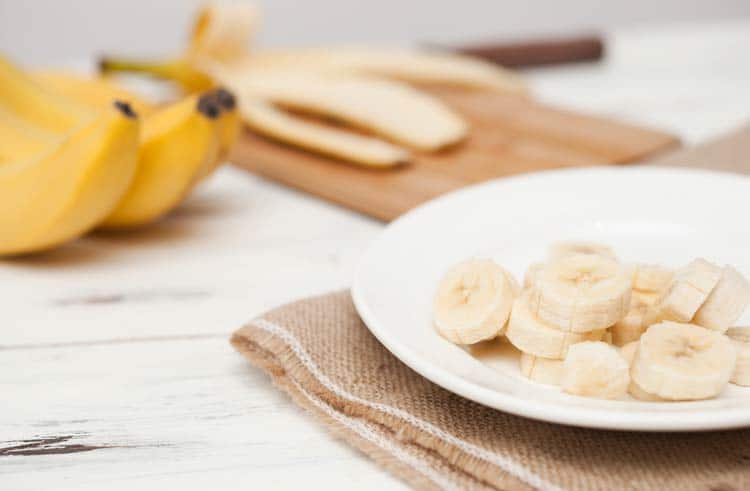
What’s even better? It is kid approved even without all the extras! So, use up those mushy bananas and try this for breakfast, or an anytime of day snack!
If you haven’t tried to make banana muffins with your kids, you should. A kids baking set really a lot of fun–it is a real baking kit that is made for kids.
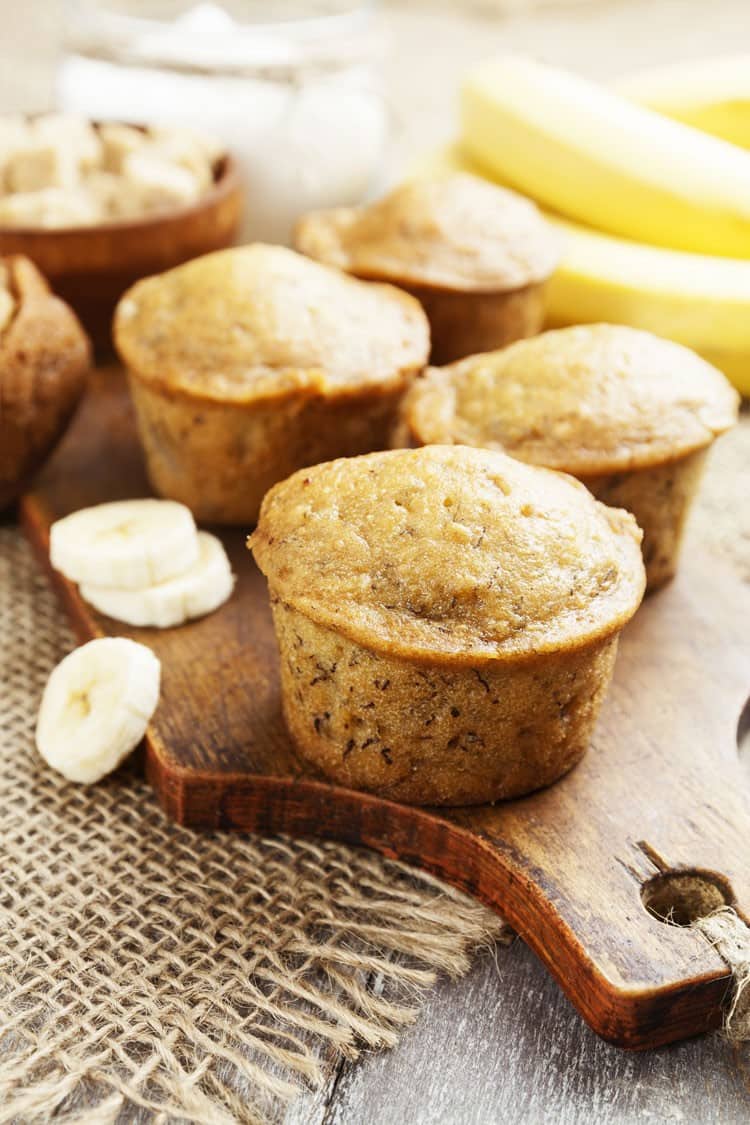
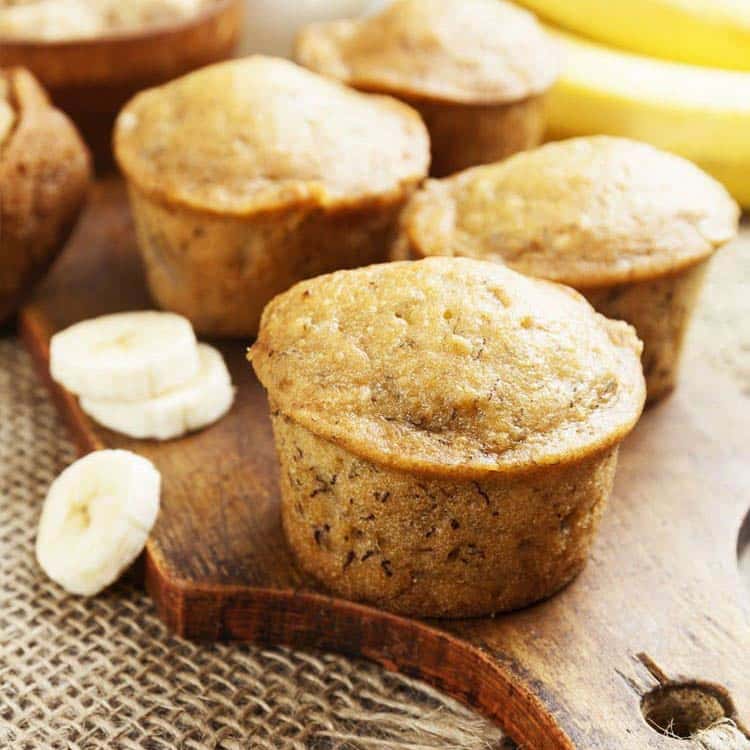
This is my family’s favorite go-to muffin recipe and they don’t last long at all.
Banana muffins are kind of like buttermilk biscuits with strawberry jam to me. These muffins are so moist and delicious it’s hard to stop at just one.
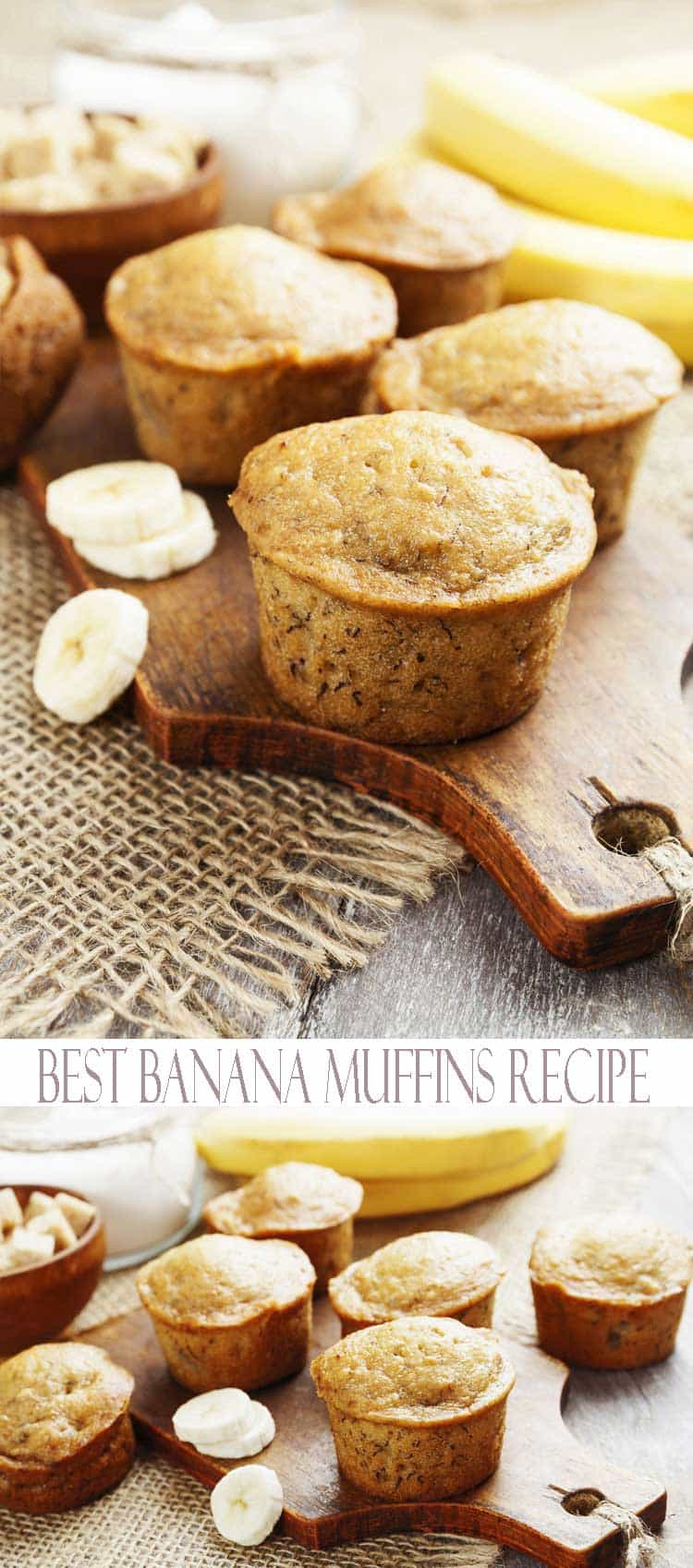
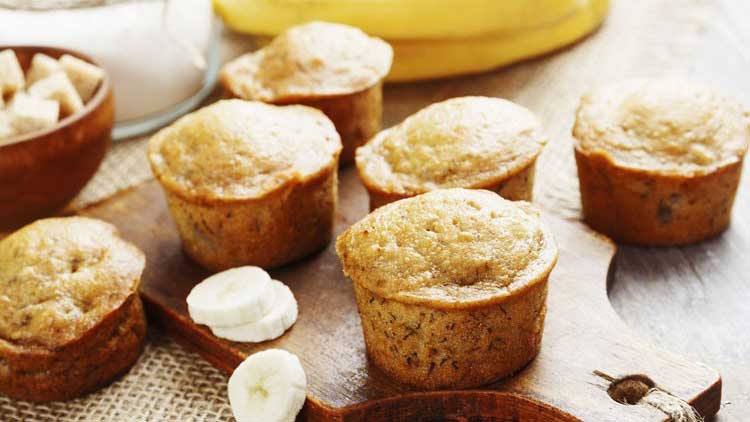
Original article and pictures take http://allshecooks.com/2013/03/05/perfect-banana-muffins-2/ site
Happy Friday everyone!
Sorry for my lengthy post-valentines day hiatus. The third trimester has made me a little slow in the kitchen and I've had my hands full with family. Like my mother, who was in town last week and thinks a day at the spa is a better use of my time than baking (hey, I'm not going to argue). Then we had Mr. Humble's laptop crashing and needing to be resurrected after the latest Windows 7 service pack, something that makes the Mac user in me smirk with smug hipster superiority.
Mr. Humble (and his laptop) were necessary for today's post, since we're using one of his bread recipes. A recipe I've been begging... scratch that, demanding he make in recent weeks. You see, I've had some pretty crazy pregnant woman cravings for all things creamy. Cheesecakes, eclairs, cream puffs, donuts, and cinnamon rolls topped with pillows of creamy goodness. Knowing that Mr. Humble's soft, tender enriched white dough makes a beautiful cinnamon roll, I lobbied hard.
Of course, once I actually got my wish for a pan of delicious freshly made cinnamon rolls, I spent more time eating them than photographing them. Thus all I have to accompany this post is a bunch of photos of minimally-staged cinnamon rolls that are in the process of being eaten.

Photographing food while pregnant is hard!
So let's get down to the how-to.
You will find that this recipe is far simpler than the sourdough cinnamon rolls found on NSHP. This recipe also produces a very soft, tender roll without the need for a sourdough starter or lengthy cold ferments. The rolls can be turned out and baked in a few hours, given optimal rising conditions in your kitchen.
Alright, I'm going to let my resident dough-maker and crazy pregnant woman care-taker commandeer the laptop and give you the run down for this dough. Before I do so though, I will mention that this is a very common tried and tested dough recipe in the Humble household, one we use whenever we require a delicious and quick enriched dough. I use it for Mother Humble's caramel pecan sticky rolls and I also bake it into loaves for a soft and tender bread. Loaves that make fantastic french toast when sliced.
Over to you Mr. Humble...

Mr. Humble's Cinnamon Roll Dough
Yields one 9"x 13" pan of rolls
Bread Flour: 700g
Whole Milk: 475g
Active Dry Yeast: 10g
Salt (Kosher): 14g
Sugar: 55g
Eggs: 61g
Butter: 74g
As you might have noticed, everything is by weight. I don't know how much it is by volume, and I'm a hardliner when it comes to baking by weight. I wouldn't even give a coworker one of my bread recipes until he bought a kitchen scale. So, if you do not have a kitchen scale, you will need one for this recipe.
I have active dry yeast on hand, but you can use other types as well. Simply use the following conversion factors: 1g Instant = 1.25g Active Dry = 2.5g Fresh.
When I make this dough, I weigh out the milk, butter, and eggs and set them aside to warm up to room temperature. I cut the butter into small cubes before weighing to make it easier to soften and handle when mixing everything together.
Weigh out your dry ingredients, and whisk them thoroughly to combine.
After everything is room temperature and ready, it is time to mix. I only mix bread by hand. In fact, I don't really know how to do it properly in a stand mixer. For me, mixing the dough by hand is an important part of making bread. You also learn a lot about what's going on with the ingredients as they slowly become dough. So, I will suggest making this dough by hand (and because I have no idea how to tell you to get the same results with a mixer).
Take your dry ingredients bowl and make a small hole in the middle of your flour mixture, and begin adding your milk, eggs, and butter. I mix with a wooden spoon or silicone scraper. To begin, slowly mix in circles around your liquids and incorporate the flour in the middle, expanding to the edges. After this, I begin folding the ingredients from the edge to the center, pressing down in the middle. Scrape down the side to incorporate anything that is stuck, fold to the middle, press, then turn the bowl and repeat. Don't forget about the bottom; make sure you don't have a layer of flour accumulating under your dough.
When the ingredients are more or less fully combined, you will have a very sticky mass of almost-dough. At this point it will be time to continue mixing outside of the bowl. Prepare a clean, dry section of counter-top and scrape your not-quite-dough out of the bowl and onto the surface. It is very sticky and it will be difficult to work with at first, but do not put flour anywhere on the dough or on your counter top or on your hands. Just prepared to make a mess until the dough comes together...and have a scraper handy.
If you want, you can dip your fingers into cold water before handling the dough. This will buy you approximately 4 seconds of clean fingers, and generally isn't worth the bother. As much as possible, use only your fingers to handle the dough. It will minimize the amount of dough that ends up sticking to you until the dough comes together properly.
For the mixing at this stage, I strongly suggest using a French fold variant. It is a very good method for hand mixing wet doughs, and there are even a few videos online demonstrating it. I think there is a link on this blog to one, even.
(Ms. Humble: There is one rather vigorous display of sticky dough handling contained within the Doughnut Post. However some slightly less aerobic French folding videos can also be found out on the web.)
Essentially, with this method, you pick up the very sticky mass with your fingers, swing the bottom up and slap it to the counter, then fold the part in your hands over the top. Then you pick it up, turn, and repeat. It is not easy at first, and it is messy on your fingers, but it is very effective. After a few minutes of this, your dough will stick to you and the counter a lot less and mainly to itself. When the dough doesn't stick to you so much any more, you can then knead the dough in pretty much any way that is comfortable to you. All that matters is that you continue mixing until you have reasonable gluten formation.
With this dough, fancy gluten windows and whatnot are completely unnecessary. You should not have any dry bits, and it should be a more-or-less cohesive blob of dough. It will be a little soft, but still fairly stiff because the gluten is not well formed.
When done, form the dough into a ball and put into a lightly-oiled bowl. The bowl should have enough room for the dough to double in size. Cover with plastic wrap and allow to rise. The time it takes to double in size will depend on the temperature of your room. If it is warm, it will rise faster, with less flavor from the yeast. If it is colder, it will rise more slowly, have a slightly different flavor, and the dough will be softer.
Unless it is really cold or your yeast is dead, the dough will eventually double, or nearly double, in size. At this point it is time to make your rolls.
This is where Mr. Humble passes off the bowl of dough to me and I get down to the serious business of assembling the rolls.
Now you have your soft mass of dough ready for rolling and cinnamon-ing. You should roll out the dough into a rectangle. How thick or thin will depend on how you like your cinnamon rolls. A thinner larger sheet will produce rolls with thin spirals, a thicker sheet of dough will produce rolls with thick spirals. Generally I roll this dough a bit larger than a standard half sheet pan, using a bit of flour to prevent sticking.
To fill the rolls you will need the following:
Cinnamon Roll Filling:
Melted butter (Salted or unsalted, your choice. Both have their merits here)
1 cup golden brown sugar, packed
1/2 cup granulated sugar
2 tablespoons ground cinnamon
Combine the brown sugar, sugar and cinnamon in a bowl until evenly mixed and lump free. Brush your sheet of dough with the melted butter and then sprinkle with a generous coating of the sugar mixture. Use it all.
Then working with the long edge of the dough sheet, roll the sheet onto itself to form a spiraled log of dough. Use a piece of dental floss or thread to cut the dough into evenly sized disks (how thick is the baker's preference. I like to cut mine just over one inch thick. If you want really massive rolls, be prepared to bake them in a smaller pan).

Arrange the rolls in a lightly buttered 9" x 13" baking dish, leaving space between them so they can expand and rise (more space than shown above. Not sure why I photographed them squashed like that...). Cover lightly with plastic wrap and preheat your oven to 350°F. (You can now freeze the rolls for later, allowing them to defrost and rise before baking.) Allow the rolls to rise in a warm spot until doubled and then you're ready to bake.
 |
Place the rolls into your oven and bake until golden brown and the dough reaches an internal temperature of 190°F. This will take roughly half an hour.
Then pull out your rolls and prepare to slather with my favorite cream cheese frosting.

Light, creamy and not too sweet, this is one of my favorite cream cheese frostings. Lightened with whip cream, it is a wonderful light but stable frosting. Of course we're talking light in the context of texture, not calories. The frosting is fantastic on carrot, red velvet cake or my pumpkin spice cake, cupcakes, cinnamon rolls and even a dip for dunking fruit.
This recipe probably makes more than enough for the rolls above, but I admit to dolloping an obscene amount onto my oven fresh buns. That's just how Ms. Humble rolls.
 |
Ms. Humble's Whipped Cream Cheese Frosting
Can and should be halved for more modest, non-crazy pregnant woman portions
16oz cream cheese, room temperature
1 1/2 cup powdered sugar
1 teaspoon vanilla
1 cup heavy cream, cold. Higher the fat content, the better (I'm using 40% Ultra)
Beat the cheese, sugar and vanilla until smooth and fluffy. In a separate bowl, beat the heavy cream to nearly stiff peaks, then add the whipped cream into the cheese mixture and quickly and briefly beat to combine. Do not over beat.
Slap goose-egg sized portions of the whipped cream cheese onto your hot cinnamon rolls and consume with pregnant woman-like abandon.
Enjoy.

Original article and pictures take http://notsohumblepie.blogspot.com/2011/03/cinnamon-rolls-with-whipped-cream.html#more site